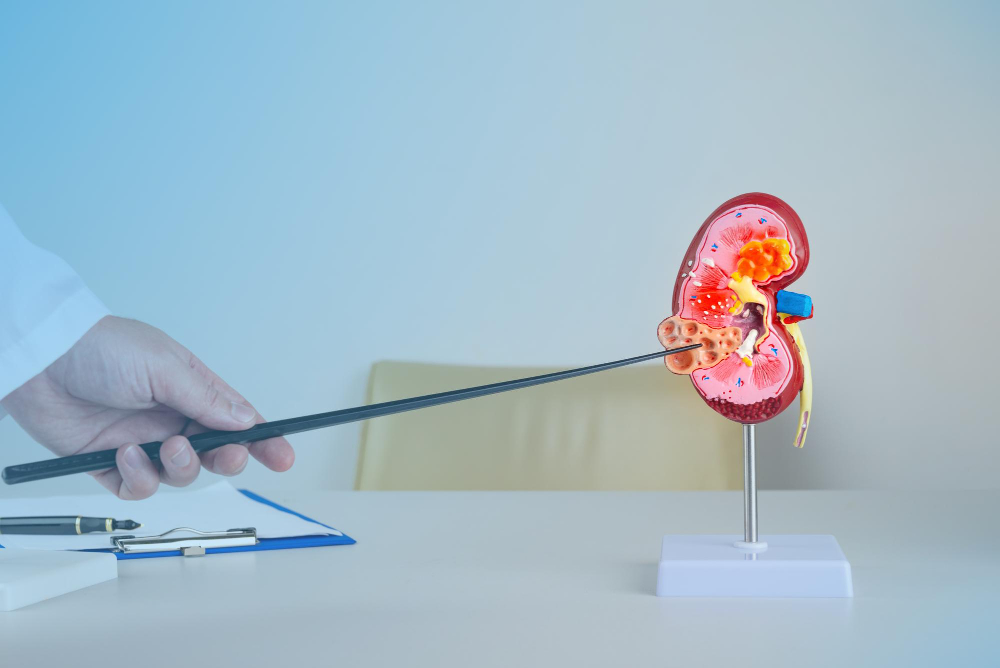
Urology

Services Offered
Kidney stone removal and prevention
Kidney stones are hard deposits of minerals and salts that form in the kidneys and can cause severe pain and discomfort. When kidney stones are large or cause complications, removal becomes necessary. Treatment options for kidney stone removal include non-invasive methods like shockwave lithotripsy, where sound waves break the stones into smaller pieces, and minimally invasive techniques like ureteroscopy or percutaneous nephrolithotomy, which use small instruments to remove or break up the stones.

Prevention of kidney stones focuses on lifestyle changes and maintaining good hydration. Drinking plenty of water helps dilute the substances in urine that lead to stone formation. A balanced diet, low in sodium and rich in fruits and vegetables, can also help prevent stones. Limiting foods high in oxalates (like spinach, nuts, and chocolate) and consuming adequate calcium can reduce the risk of stone formation. Medications may be prescribed in certain cases to help prevent the recurrence of stones, especially for individuals with a history of frequent stones.
Early diagnosis and treatment are essential to avoid complications like urinary tract infections or kidney damage. Regular check-ups and lifestyle modifications can significantly reduce the chances of kidney stone recurrence.
Prostate cancer screening and management

Prostate cancer is one of the most common cancers among men, affecting the prostate, a small gland that produces seminal fluid. Early detection is crucial for effective treatment and improving outcomes. Prostate cancer screening typically involves blood tests for prostate-specific antigen (PSA) and may include a digital rectal exam (DRE) to detect any abnormalities in the prostate. Based on these tests, further diagnostic methods such as biopsy, ultrasound, or MRI may be recommended for accurate diagnosis.
Management of prostate cancer varies based on the stage of cancer and the patient’s overall health. Options may include active surveillance for low-risk cases, where regular monitoring is done without immediate treatment. For more advanced cases, treatments may involve surgery, radiation therapy, hormone therapy, chemotherapy, or a combination of these. Robotic-assisted surgery has become a preferred option for prostate removal due to its precision and minimal recovery time.
Ongoing research and advancements in prostate cancer treatments offer hope for more personalized care. Early detection, timely intervention, and a tailored treatment plan play a significant role in successfully managing prostate cancer and improving survival rates.
Treatment for Urinary Incontinence
Urinary incontinence refers to the involuntary leakage of urine, a condition that can affect people of all ages but is more common in older adults. It can be caused by various factors, including weak pelvic muscles, nerve damage, bladder infections, or certain medications. The severity of incontinence can range from occasional leaks to complete loss of bladder control.
The treatment for urinary incontinence depends on the underlying cause and the severity of the condition. Non-surgical treatments typically include pelvic floor exercises (Kegel exercises), lifestyle changes such as weight management and avoiding bladder irritants, and medications to relax the bladder or reduce overactive bladder symptoms.

In more severe cases, surgical options may be considered. These can include sling procedures, bladder neck suspension, or injections to help improve bladder control. For some patients, Botox injections into the bladder muscle or the use of a nerve stimulator may also be effective.
With proper diagnosis and treatment, urinary incontinence can often be managed successfully, improving quality of life for those affected. Regular consultation with a healthcare provider is essential to determine the best treatment plan tailored to each individual.
Urinary retention

Urinary retention is a condition where an individual is unable to fully empty their bladder. This condition can be acute, where the inability to urinate comes on suddenly and is often painful, or chronic, where the person experiences difficulty urinating over an extended period of time. It may be caused by a variety of factors including obstructions (like an enlarged prostate in men), weakened bladder muscles, nerve damage, infections, or medications.
The treatment for urinary retention depends on the underlying cause. For acute urinary retention, immediate medical attention is required, and treatment typically involves catheterization to drain the bladder. Chronic urinary retention may require additional interventions.
Non-invasive treatments include pelvic floor exercises to strengthen bladder muscles, medications to help relax the bladder or relieve obstruction, and lifestyle changes to avoid fluid retention and manage fluid intake. In cases where an obstruction is causing the retention, surgery may be necessary to remove the blockage, such as prostate surgery in men.
In some cases, surgical procedures like bladder neck procedures or the use of a catheter to help empty the bladder regularly may be recommended. A thorough diagnosis from a healthcare provider is essential for determining the appropriate treatment plan to restore normal bladder function.

